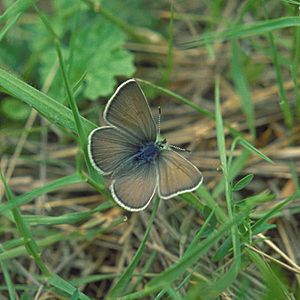Fender's blue butterfly facts for kids
The Fender's blue butterfly (Icaricia icarioides fenderi) is a very special and rare butterfly. It lives only in the Willamette Valley in Oregon, USA. This butterfly is an endangered species, which means it's in danger of disappearing forever.
Quick facts for kids Icaricia icarioides fenderi |
|
|---|---|
 |
|
| Conservation status | |
| Scientific classification |
|
| Kingdom: | Animalia |
| Phylum: | Arthropoda |
| Class: | Insecta |
| Order: | Lepidoptera |
| Family: | Lycaenidae |
| Genus: | Icaricia |
| Species: | |
| Subspecies: |
I. i. fenderi
|
| Trinomial name | |
| Icaricia icarioides fenderi (Macy, 1931)
|
|
| Synonyms | |
|
|
Scientists first learned about this butterfly in the 1920s. A biologist named Ralph Macy officially described it in 1931. He named it after his friend, Kenneth Fender, who studied insects.
After the 1930s, people thought the Fender's blue butterfly had vanished. But in 1989, small groups of them were found again! Sadly, Kenneth Fender had passed away nine years before his namesake butterfly was rediscovered.
In 2000, the U.S. Fish and Wildlife Service officially listed the Fender's blue butterfly as an endangered species. Today, the largest known groups of these butterflies live in the Baskett Slough National Wildlife Refuge. In 2014, some butterflies were even moved to the William L. Finley National Wildlife Refuge to help create new populations. This butterfly's home area stretches from south of Portland, Oregon, to south of Eugene, Oregon.
Life Cycle and Habitat
The Fender's blue butterfly has a very close relationship with a specific plant called Kincaid's lupine. This plant is a rare type of sulphur lupine. The butterfly needs this plant to survive.
In spring, the adult female butterfly lays her eggs on the Kincaid's lupine plant. When the eggs hatch, tiny caterpillars emerge. These caterpillars eat the plant and then spend the winter hidden in the plant's root system.
In the spring, the caterpillars continue to eat and grow. After a while, they go through a big change called metamorphosis. This is when they transform into adult butterflies.
Adult Fender's blue butterflies live for only about three weeks. During this short time, they mate. The female butterfly then searches for Kincaid's lupine plants to lay her own eggs, starting the cycle all over again.
Sadly, the places where Kincaid's lupine grows have become much smaller. This is because of farming and cities growing bigger. Only a few special areas still have enough land for both the lupine and the Fender's blue butterfly to live.
Images for kids



